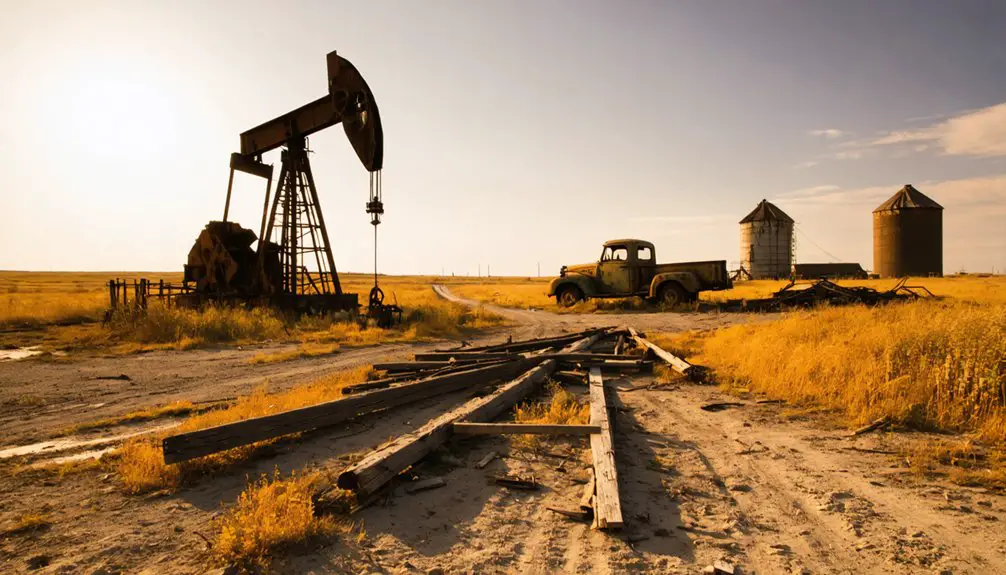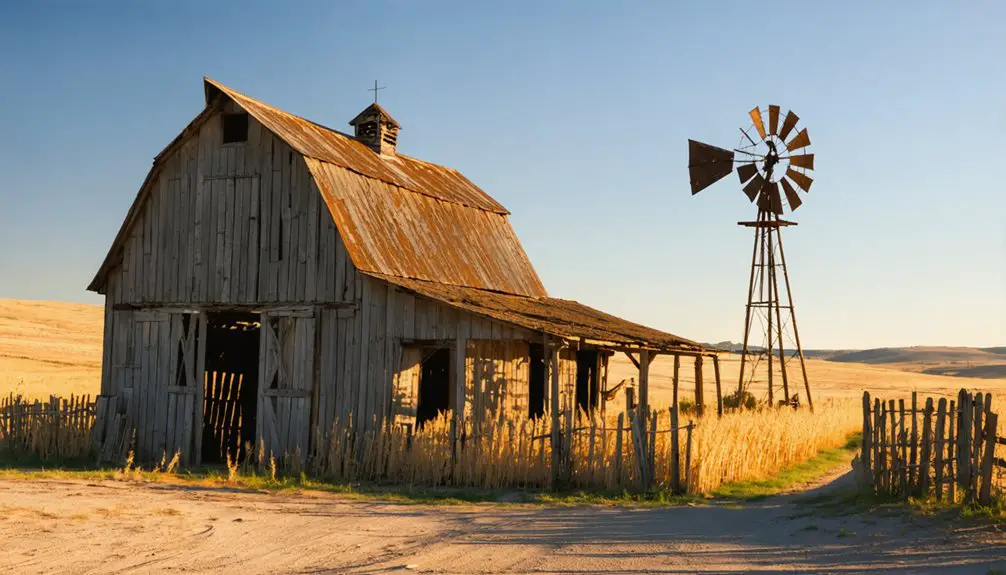You’ll find Santa Fe, Oklahoma’s remains near the historic Atchison, Topeka, and Santa Fe Railway line, where it emerged from a military outpost in the 1860s. At its peak, over 200 families thrived in this frontier community, supported by limestone quarrying, railroad commerce, and agriculture. The town’s fate shifted when railway routes changed, leading to its eventual abandonment. Its silent streets and deteriorating structures tell a complex tale of resource depletion, environmental challenges, and frontier resilience.
Key Takeaways
- Santa Fe emerged as a frontier settlement in the late 1800s around military outposts and the Atchison, Topeka, and Santa Fe Railway.
- The town thrived with over 200 families supported by resource extraction, railroad commerce, and agriculture.
- Rerouting of the main railway line led to Santa Fe’s economic decline and eventual abandonment.
- Environmental hazards from mining left dangerous levels of lead and zinc contamination in soil and water.
- The ghost town exemplifies the boom-and-bust cycle of frontier communities and now attracts heritage tourism interest.
Origins and Early Settlement of Santa Fe
The untamed frontier that would become Santa Fe, Oklahoma, emerged not from the famous trail bearing its name, but from the convergence of military outposts and railroad development in the late 1800s.
You’ll find that Camp Nichols, established in 1865, provided the first significant military presence in the region, offering protection against raids through its stone-walled dugouts and defensive moats.
While the Santa Fe Trail passed through Oklahoma, it wasn’t until the arrival of the Atchison, Topeka, and Santa Fe Railway that permanent settlement took root. Like many ghost towns in Oklahoma, the settlement’s fate would be determined by factors such as resource depletion and changing transportation routes. The town’s eventual decline mirrored that of Burke City’s abandonment due to flooding.
The railroad sparked industrial growth, particularly in limestone quarrying and concrete production. Cultural interactions between Native American scouts, military families, and early settlers shaped the community’s character, though the nearest established town, Wheeless, wouldn’t appear until 1907.
Life on the Frontier: Daily Existence in Early Santa Fe
Daily existence in early Santa Fe revolved around stark practicality, with residents adapting to frontier challenges through simple yet functional living spaces. You’d find homes built from local wood and stone, often serving multiple purposes as both living quarters and workspaces.
Life in this frontier community centered on company-controlled schedules, with your daily routines dictated by work shifts at quarries or railroad construction sites. You’d gather at communal cookhouses for meals, pick up supplies at the commissary, and socialize at the local saloon. Like the early Spanish and French traders who once traversed these lands, residents established vital trade networks with neighboring settlements. The Cold Spring station provided a crucial water source for the community’s survival.
The post office served as your connection to the outside world, while shared hardships forged tight-knit bonds among neighbors. Your social standing would be reflected in your housing quality and access to community resources, creating a clear hierarchy within the settlement.
Economic Rise and Peak Years
During Santa Fe’s economic zenith, three major industries – resource extraction, railroad commerce, and agriculture – transformed this frontier outpost into a bustling trade center.
You’d find over 200 families thriving in a community where economic diversification created unprecedented opportunities. The strategic placement of the Santa Fe Railway depot spurred growth in mining, quarrying, and cotton production. Like many towns that experienced boom-and-bust cycles, Santa Fe’s prosperity was vulnerable to economic downturns.
Local businesses flourished as resource management drove prosperity. You could shop at grocery stores, hardware shops, and dry goods merchants, or visit the town’s saloons, hotels, and blacksmiths.
Cotton gins served regional farmers, while quarries supplied materials for construction and railroad maintenance. This dynamic mix of industries created a self-sustaining economy that supported both industrial workers and agricultural producers, marking Santa Fe’s most prosperous era.
Transportation Routes and Their Impact
You’ll find the early rail route decisions by the Santa Fe Railway shaped the destiny of numerous Oklahoma communities, with towns either thriving or fading based on their proximity to the tracks.
While some settlements benefited from strategic positioning near the railway’s 1902 depot installations, others lost up to 80% of their population after being bypassed by the crucial transportation artery.
The original trail networks that preceded the railroad left their mark on the region’s development, but it was the Santa Fe’s rail lines that ultimately determined which communities would survive and which would join the ranks of Oklahoma’s ghost towns. The Eastern Oklahoma Railway transported an impressive 125 cattle cars in a single day during 1907, demonstrating the vital role of rail transportation. The Santa Fe continued expanding into the 1930s, constructing lines in the Panhandle to serve the growing wheat districts.
Railroad Bypass Effects
While the Santa Fe Railway initially brought prosperity to numerous Oklahoma settlements, its subsequent routing decisions and line abandonments played a decisive role in Sante Fe’s transformation into a ghost town.
You’ll find that railroad economics dictated the fate of many communities, as rail companies prioritized routes connecting major trade centers and resource-rich areas for maximum profit. The construction of an alternative main line through Newkirk, Cushing, and Shawnee to Pauls Valley between 1900-1904 shifted traffic patterns significantly.
When the Santa Fe Railway reduced traffic through Sante Fe by establishing alternate routes, the town’s significance began to fade. The first red depot built in 1887 marked the town’s early promise as a vital railway stop.
The bypass triggered a chain reaction of town relocation, as businesses and residents moved to communities still served by active rail lines.
Without direct access to this essential transportation artery, Sante Fe lost its commercial importance and eventually joined other bypassed settlements that became ghost towns in eastern Oklahoma.
Early Trail Significance
Before railroads transformed the American frontier, the Santa Fe Trail served as an essential commercial and military artery connecting the Midwest to the Southwest.
You’ll find the Cimarron Route cutting through Oklahoma’s western panhandle, where trail commerce faced some of its greatest challenges. Wagon trains had to navigate stretches of over 50 miles without reliable water sources, often forcing travelers to dig into dry riverbeds just to quench their thirst. The route carried an impressive 75 percent of traffic along the entire trail.
While military logistics benefited from defensive positions like Camp Nichols, established in 1865, the trail’s impact on local development remained minimal.
Unlike other regions along the 900-mile route, the Oklahoma section didn’t spawn permanent settlements during its active years. The trail’s primary legacy here lies in its role supporting westward expansion rather than fostering local growth.
Natural Resources and Environmental Challenges

As mining operations flourished in the Santa Fe region during its heyday, they left behind a devastating environmental legacy that continues to plague the area today.
You’ll find massive piles of toxic mine tailings, known as “chat,” that contaminate the soil and groundwater with dangerous levels of lead and zinc. The resource depletion from decades of unrestricted mining created treacherous underground voids, threatening building stability and land surfaces.
Environmental pollution has made the area nearly uninhabitable, with 34% of children in nearby Picher suffering from lead poisoning.
The toxic legacy of mining has turned communities toxic, with over one-third of Picher’s children experiencing dangerous lead exposure.
You can’t safely use local water sources due to heavy metal contamination, and the EPA’s ongoing Tar Creek Superfund cleanup faces significant challenges.
Abandoned mine shafts pose constant subsidence risks, making redevelopment virtually impossible.
The Great Decline: Factors Behind Abandonment
The dramatic decline of Santa Fe mirrors a pattern seen across numerous Western ghost towns, where multiple destabilizing forces converged to hollow out once-thriving communities.
You’ll find the town’s story follows a familiar trajectory: shifting transportation routes dealt the first blow, as newer highways bypassed the settlement, causing roadside businesses to shutter.
The loss of these commercial anchors weakened social cohesion, prompting younger residents to seek opportunities elsewhere. Without economic diversification to sustain it, Santa Fe couldn’t adapt to changing times.
The closure of essential services, including the post office and local shops, accelerated the exodus. As the population aged and dwindled, community gathering places fell silent, and the once-bustling streets emptied, leaving behind only echoes of its former liveliness.
Notable Characters and Local Legends

You’ll find that Santa Fe’s landscape was shaped by complex interactions between lawmen pursuing outlaws along the whiskey trade routes and frontier merchants operating both legitimate and illicit businesses near the Oklahoma territories.
The area’s character was deeply influenced by Native American leaders who maintained diplomatic relations with military personnel while protecting their communities during periods of tribal conflict.
Local folklore still echoes with tales of colorful personalities from Camp Nichols, including Colonel Kit Carson and his efforts to secure the Santa Fe Trail alongside indigenous scouts.
Outlaws and Lawmen History
During the late 19th century, Sante Fe’s landscape became a battleground between notorious outlaw gangs and determined lawmen, with groups like the Dalton Gang, Wild Bunch, and High Fives Gang terrorizing the Oklahoma Territory through train robberies and violent raids.
These outlaw confrontations shaped the region’s history, with brave lawmen like Deputies Sid Johnson and Will Loomis risking their lives to protect the community.
The most significant lawman legacies emerged from three key events:
- The 1892 Santa Fe Railroad robbery near Wharton
- The deadly 1894 gun battle at Ingalls that claimed three deputies’ lives
- The fierce shootout at Red Rock that wounded railroad detective John J. Kinney
The “Three Guardsmen,” U.S. Marshals specially assigned to capture the Wild Bunch, embodied the territory’s relentless pursuit of justice.
Frontier Trade Personalities
Beyond the era of outlaws and lawmen, Sante Fe’s commercial landscape teemed with colorful personalities who shaped the town’s frontier identity.
You’d find frontier merchants operating from wooden shanties, serving as crucial hubs where settlers gathered to trade goods and share news. These legendary traders navigated complex relationships between Native tribes and settlers while keeping essential supplies flowing through the community.
Railroad entrepreneurs brought new prosperity through the Atchison, Topeka and Santa Fe Railway, while local craftsmen like blacksmiths kept the wheels of commerce turning.
At gathering spots like the Ringo Hotel and Happy Hill Church, business figures and religious leaders wielded significant influence over trade and community affairs.
Tales of their exploits – from surviving raids to outsmarting competitors – live on in local museums, painting a vivid picture of frontier commerce.
Native Leaders’ Local Impact
Native leaders shaped the intricate cultural and political landscape around Santa Fe through their resilience, diplomacy, and resistance. You’ll find their influence reflected in the region’s complex history of cultural adaptation and determined leadership. Quanah Parker exemplified this transformation as he guided the Comanche through radical changes while preserving essential traditions.
During the tumultuous Civil War period, native leadership faced critical challenges:
- Cherokee and Creek leaders initially sought neutrality
- Confederate alliances fractured tribal unity
- Post-war treaties stripped away significant land rights
The Santa Fe area witnessed the strategic influence of Pawnee leaders who maintained independence while maneuvering new trade relationships.
Meanwhile, Geronimo’s fierce resistance against U.S. expansion reverberated throughout the territory, embodying the Apache people’s struggle for sovereignty and inspiring generations of freedom fighters.
Remaining Structures and Physical Evidence

While many ghost towns across Oklahoma have succumbed to time and the elements, several key structures continue to stand as proof of the region’s pioneer history.
Abandoned yet enduring, Oklahoma’s ghost town structures stand as silent witnesses to the pioneering spirit of early settlers.
You’ll find that wooden frame buildings dominate the remaining structures, reflecting the late 19th and early 20th-century frontier architectural styles that defined these settlements. Churches, particularly those built with local stone foundations, have proven most resilient against decay.
While commercial buildings like saloons are rare survivors, you can still spot deteriorating remnants of schools, like the Jefferson School, which once served as community centers.
The physical evidence of infrastructure is limited, with most railroad alignments and mining facilities existing only as archaeological traces. Cemeteries often remain the best-preserved sites, offering tangible connections to the area’s past inhabitants.
Historical Significance in Oklahoma’s Development
You’ll find Santa Fe’s historical importance reflected in its role as an early frontier settlement, where it served as a significant checkpoint along Native American trade routes before European-American expansion.
The town’s strategic location near Cold Springs Creek made it valuable for both indigenous traders and settlers until railroad development in Oklahoma Territory shifted transportation patterns away from traditional trail networks.
Your understanding of Oklahoma’s development gains deeper context when you consider how Santa Fe exemplified the common pattern of boom-and-bust cycles that characterized many frontier communities, particularly those dependent on trail-based commerce before railroad infrastructure transformed the region.
Early Frontier Settlement Patterns
During Oklahoma’s remarkable frontier settlement period, which condensed decades of typical westward expansion into just ten years starting in 1889, settlers transformed former Indian Territory through a complex web of legal, social, and cultural changes.
You’ll find that early settlers faced significant frontier challenges, building dugouts and sod houses while adapting to harsh prairie conditions and economic hardships.
The cultural adaptations were profound, as settlers from southern and midwestern regions encountered diverse Native American groups, including:
- The Five Tribes (Cherokee, Choctaw, Chickasaw, Creek, Seminole)
- Plains tribes like the Kiowa and Apache
- The Osage nation
Despite the complex interactions and displacement of indigenous peoples, community solidarity emerged as settlers established small towns along transportation routes, with buildings serving multiple civic functions.
Railroad Impact and Growth
As the Santa Fe Railroad systematically expanded across Oklahoma from 1900 to 1928, its strategic network transformed the territory’s economic and social landscape.
You’ll find the railroad’s influences reached far beyond mere transportation – they fundamentally shaped how communities developed and thrived. The railway company carefully selected town sites, designed orderly street layouts, and positioned central stations to maximize growth potential.
Santa Fe’s strategic planning created a robust network of approximately 1,500 miles connecting oil fields, agricultural centers, and emerging markets.
The railroad’s independent funding approach meant they could focus on profitable routes that served community interests. Through their deliberate town development strategy, they established essential links between extraction sites, refineries, and shipping points, while simultaneously supporting agricultural diversification and industrial expansion across the territory.
Native American Trade Routes
Long before European settlers arrived, indigenous trade networks crisscrossed Oklahoma’s landscape, creating essential economic and cultural connections across North America.
These indigenous commerce routes, particularly strong between A.D. 1 and 300, connected thriving communities like Spiro Mounds to distant regions, facilitating the exchange of goods and ideas.
You’ll find that these trade relationships established lasting patterns that shaped Oklahoma’s development through:
- Major settlement locations along rivers that became economic hubs
- Exchange networks that connected the Gulf Coast to Lake Superior
- Cultural blending that fostered technological innovation
These ancient pathways later influenced the placement of European trading posts along the Arkansas, Canadian, and Red Rivers, demonstrating how Native American trade routes laid the foundation for Oklahoma’s modern economic corridors.
Legacy and Modern-Day Historical Tourism
While the Santa Fe Trail once bustled with wagon trains and traders, today’s Sante Fe ghost town in Oklahoma draws visitors enthusiastic to explore its rich historical legacy.
You’ll find guided walking tours that blend cultural heritage with compelling ghost stories, bringing the frontier’s dramatic past to life. At nearby Cold Springs Creek, you can examine Autograph Rock’s inscriptions from 1850-1865, tangible remnants of those who traveled west.
Step back in time as frontier tales and pioneer signatures reveal the untold stories of America’s westward journey.
The site preserves authentic artifacts, from wagon parts to iron-rimmed wheels, while historical markers near Wolf Mountain commemorate trail conflicts and trading activities.
You’re part of a growing trend of heritage tourism, as ghost town enthusiasts help transform this once-abandoned settlement into a destination that connects you with the raw spirit of westward expansion.
Frequently Asked Questions
Are There Any Documented Paranormal Activities or Ghost Sightings in Santa Fe?
You won’t find any verified ghost encounters or haunted locations in this area, as available research and community records don’t document any paranormal activities or confirmed supernatural sightings.
What Happened to the Cemetery and Burial Sites From Santa Fe?
You’ll find bodies were moved from the original Masonic cemetery to Fairview and Santa Fe National Cemetery during burial site investigations, though some remains were later discovered during excavations despite cemetery preservation efforts.
Did Any Famous Western Movies Use Santa Fe as a Filming Location?
You won’t find any famous Western filmography or cinematic legacy connected to Santa Fe, Oklahoma. Historical records don’t support claims of Western movies being filmed at this ghost town’s location.
Were There Any Notable Native American Conflicts in Santa Fe’s History?
Like storm clouds gathering, you’ll find a history of Native American conflicts where Ute and Apache tribes launched fierce resistance against settlers, staging raids and battles along the Santa Fe Trail during the 1840s-1850s.
What Artifacts From Santa Fe Can Be Found in Oklahoma Museums Today?
You’ll find Santa Fe artifacts in Oklahoma museums including trail relics, railroad memorabilia, and historic structures at the Cimarron Heritage Center and Pottawatomie County Museum, showcasing the region’s historical significance.
References
- https://en.wikipedia.org/wiki/List_of_ghost_towns_in_Oklahoma
- https://www.santafeinsiders.com/blog/2397370_forgotten-frontiers-the-ghost-towns-that-surround-santa-fe
- https://www.legendsofamerica.com/ok-kenton/
- https://www.okhistory.org/publications/enc/entry?entry=GH002
- https://www.legendsofamerica.com/ok-santafetrail/
- https://www.beaversbendcreativeescape.com/se-oklahoma-ghost-towns/
- https://gateway.okhistory.org/ark:/67531/metadc2031786/m2/1/high_res_d/1996-v74-n02_a03.pdf
- https://www.okhistory.org/historycenter/forms/timeline.pdf
- https://www.okhistory.org/publications/enc/entry?entry=EU002
- https://okfronline.com/2016/07/the-abandoned-santa-fe-depot/



